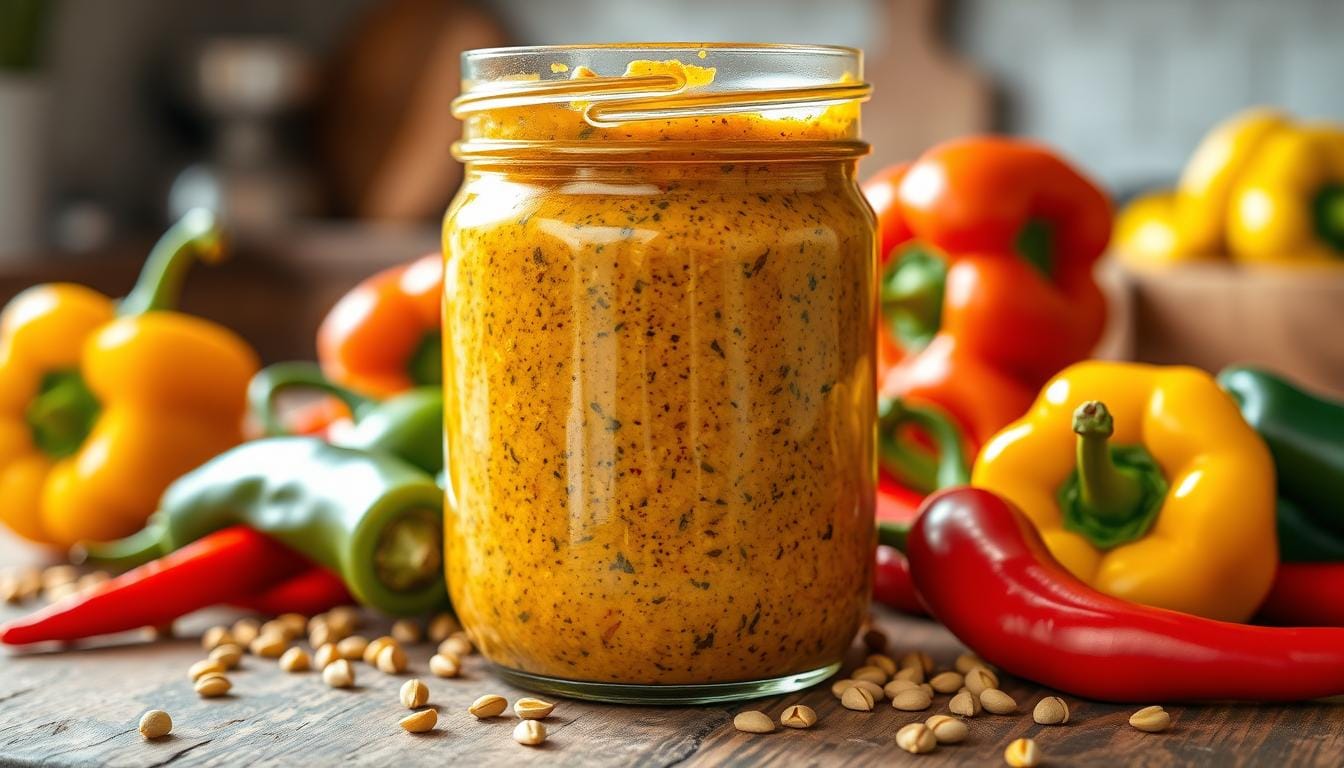
Growing up, I loved watching my grandmother make magic with simple ingredients. Her hot pepper with mustard recipe was a highlight. It sparked my love for cooking.
Making a spicy pepper mustard dish is more than mixing ingredients. It’s about the heat and character each pepper adds. This recipe is quick, taking less than 20 minutes, and will change your condiment game.
If you love spicy food or want to spice up your meals, this recipe is for you. You’ll learn to make a sweet and spicy spread. It’s perfect for elevating sandwiches, burgers, and hot dogs.
Prepare for a flavor journey that blends tradition with fresh ingredients. Your taste buds are in for a treat!
Table of Contents
Understanding the Perfect Blend of Peppers and Mustard
Making the ultimate tangy mustard pepper condiment is like an art. It mixes old traditions with new flavor ideas. Your adventure into spicy condiments starts with knowing how hot peppers and mustard work together.
The story of fiery mustard pepper sauce goes back generations. Mustard seeds have been key in cooking for thousands of years. Each culture has added its own twist to this ingredient.
History of Spicy Mustard Condiments
Spicy mustard has a rich history worldwide. It’s more than just a condiment. Ancient times saw the power of mustard seeds, inspiring today’s chefs.
- Ancient Romans first cultivated mustard as a condiment
- European monasteries developed sophisticated mustard recipes
- American cuisine embraced spicy mustard variations
Evolution of Hot Pepper Preparations
Hot pepper preparations have changed a lot. Chefs and home cooks keep trying new peppers to find unique tastes.
| Pepper Variety | Scoville Rating | Flavor Profile |
|---|---|---|
| Habanero | 100,000 – 350,000 | Intense, fruity heat |
| Jalapeno | 3,500 – 8,000 | Mild to medium heat |
| Cayenne | 30,000 – 50,000 | Sharp, burning sensation |
Cultural Significance in American Cuisine
American food loves the bold taste of hot pepper mustard. It’s become a key part of our dishes. Different places in the U.S. show how creative and varied our flavors can be.
“A great mustard is more than a condiment – it’s a celebration of flavor and tradition.” – Culinary Expert
Exploring hot pepper mustard is a tasty trip through flavors, traditions, and new ideas. Every batch has its own story of taste, passion, and culture.
Essential Ingredients for Hot Pepper with Mustard Recipe
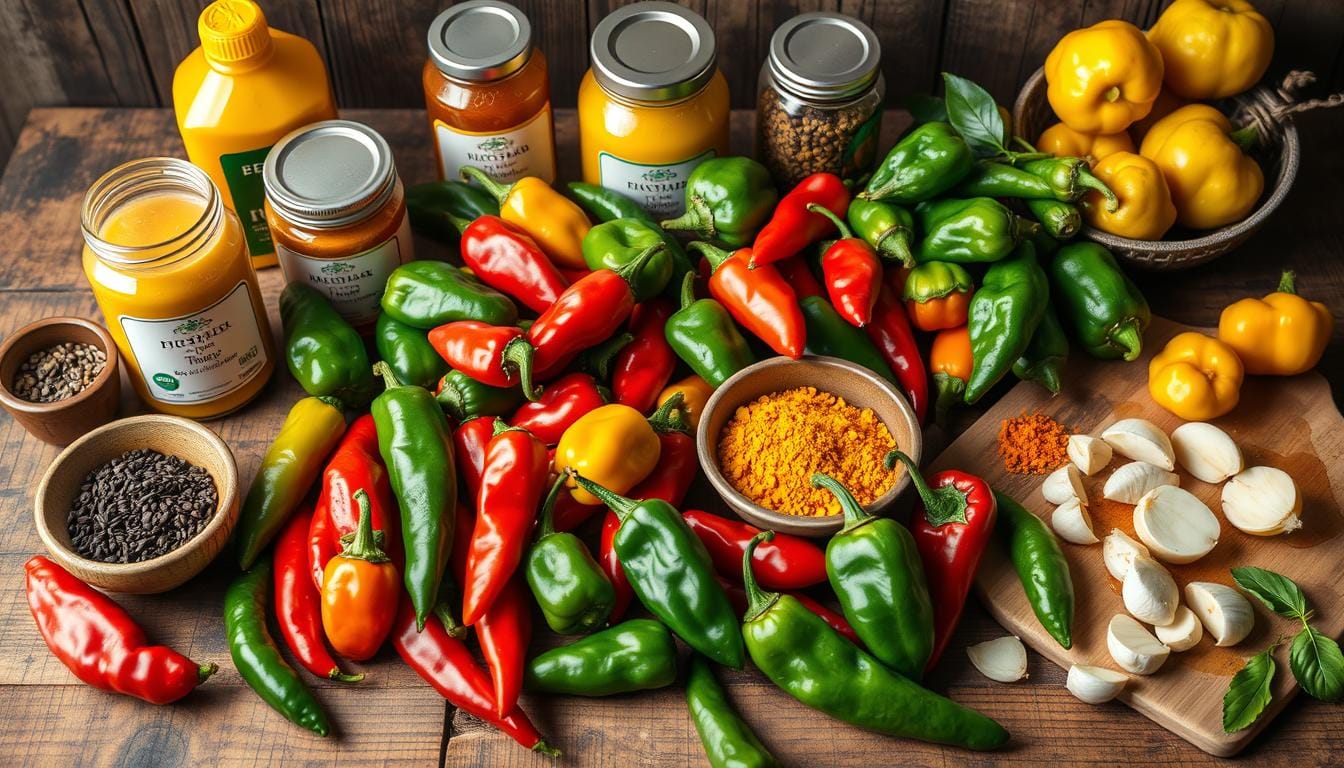
Starting your hot pepper mustard journey requires top-notch ingredients. Your mix of peppers and mustard needs the right stuff for great taste and heat.
Here are the key ingredients for your hot pepper mustard:
- Peppers (40 banana peppers or mixed varieties)
- 4 cups prepared yellow mustard
- 3 cups brown sugar
- 2 cups white sugar
- 4 cups apple cider vinegar
- 1 tablespoon salt
- 1-1/2 cups all-purpose flour
- 1 cup water
“The secret to an exceptional hot pepper mustard lies in balancing heat and sweetness.” – Culinary Experts
The type of pepper you choose greatly affects the taste. Here’s a guide to pepper heat levels:
| Pepper Type | Scoville Heat Units |
|---|---|
| Banana Pepper | 0-500 |
| Jalapeño | 2,500-8,000 |
| Serrano | 10,000-25,000 |
| Habanero | 100,000-300,000 |
For a honey mustard variation, just add 1 cup of honey. Always wear gloves when handling hot peppers. You can also adjust the heat to your liking.
Selecting the Right Peppers for Your Recipe
When making a savory hot pepper with mustard dip, picking the right peppers is key. Your zesty mustardy pepper recipe will shine with the perfect peppers. These should balance heat and flavor well.
Knowing about pepper varieties is crucial for a great condiment. Each pepper has its own heat and taste. This can make your recipe stand out.
Heat Level Guide
The Scoville Heat Unit (SHU) scale helps pick peppers by heat level:
- Poblano: Mild (1,000-2,000 SHU)
- Jalapeño: Medium (3,500-8,000 SHU)
- Serrano: Hot (10,000-23,000 SHU)
- Cayenne: Very Hot (30,000-50,000 SHU)
- Habanero: Extremely Hot (100,000-350,000 SHU)
Popular Pepper Varieties
| Pepper Type | Heat Level | Flavor Profile |
|---|---|---|
| Banana Peppers | Mild | Sweet, Tangy |
| Jalapeños | Medium | Sharp, Grassy |
| Habaneros | Very Hot | Fruity, Intense |
Seasonal Availability Tips
Fresh peppers are best in late summer and early fall. Visit farmers markets and local gardens for the best picks. You can also pickle extra peppers to enjoy their taste all year.
Pro tip: Always wear gloves when handling hot peppers to protect your skin from capsaicin.
Choose peppers that are firm, bright, and without blemishes. The peppers you pick will shape the taste of your savory hot pepper with mustard dip.
Choosing Quality Mustard Base Components
Creating a great hot pepper with mustard recipe begins with top-notch mustard ingredients. The quality and type of mustard seeds you pick are crucial for your spicy pepper mustard dish.
Mustard seeds are the base of your hot condiment. Each type has its own special traits:
- Yellow mustard seeds: Mild and gentle, great for beginners
- Brown mustard seeds: Slightly more intense flavor
- Black mustard seeds: Most pungent and strongest taste
When making your hot pepper with mustard recipe, keep these ingredient factors in mind:
| Mustard Seed Type | Flavor Intensity | Best Used For |
|---|---|---|
| Yellow Seeds | Mild | Beginner-friendly recipes |
| Brown Seeds | Medium | Traditional spicy pepper mustard dish |
| Black Seeds | Strong | Gourmet, intense condiments |
“The secret to an outstanding mustard lies in understanding your ingredients’ unique characteristics.”
Your vinegar choice greatly affects the taste. Try apple cider, white wine, or traditional vinegar to find your favorite flavor. Cold water helps keep the mustard’s pungency during making.
Adding kosher salt, light brown sugar, and ground turmeric can make your spicy pepper mustard dish truly special.
Step-by-Step Preparation Process
Making a tangy mustard pepper condiment needs care and skill. Your homemade hot pepper spread will turn simple ingredients into a special treat.
Proper Pepper Handling Techniques
When making your spicy condiment, safety comes first. Always wear gloves to avoid skin irritation from hot peppers. You’ll use about 25 medium jalapeño peppers, which is 1.5 pounds or 675 grams.
- Wash peppers well under cool water
- Remove stems and seeds carefully
- Chop peppers into small, even pieces
- Don’t touch your face or eyes while preparing
Mixing and Blending Methods
Mixing is crucial for a great homemade hot pepper spread. Mix chopped peppers with mustard base gently. This ensures flavors are evenly spread.
| Ingredient | Quantity | Purpose |
|---|---|---|
| Jalapeño Peppers | 25 medium | Primary heat source |
| Vinegar | 50% of liquid | Preservation and tanginess |
| Water | 50% of liquid | Dilution and consistency |
Temperature Control Tips
Controlling temperature is key to the perfect consistency in your tangy mustard pepper condiment. Heat your mix to a boil, stirring constantly. This prevents burning. Aim for a thick, spreadable texture that showcases your homemade hot pepper spread.
“Patience and attention to detail transform simple ingredients into an extraordinary condiment.” – Culinary Experts
Your final product will fill about 8 half-pint jars. Each jar has just 48 calories. It’s perfect for charcuterie boards, pretzels, and smoked meats!
Advanced Cooking Techniques for Perfect Consistency
Creating a fiery mustard pepper sauce is an art that needs precision and skill. The right consistency is key for a great taste experience.
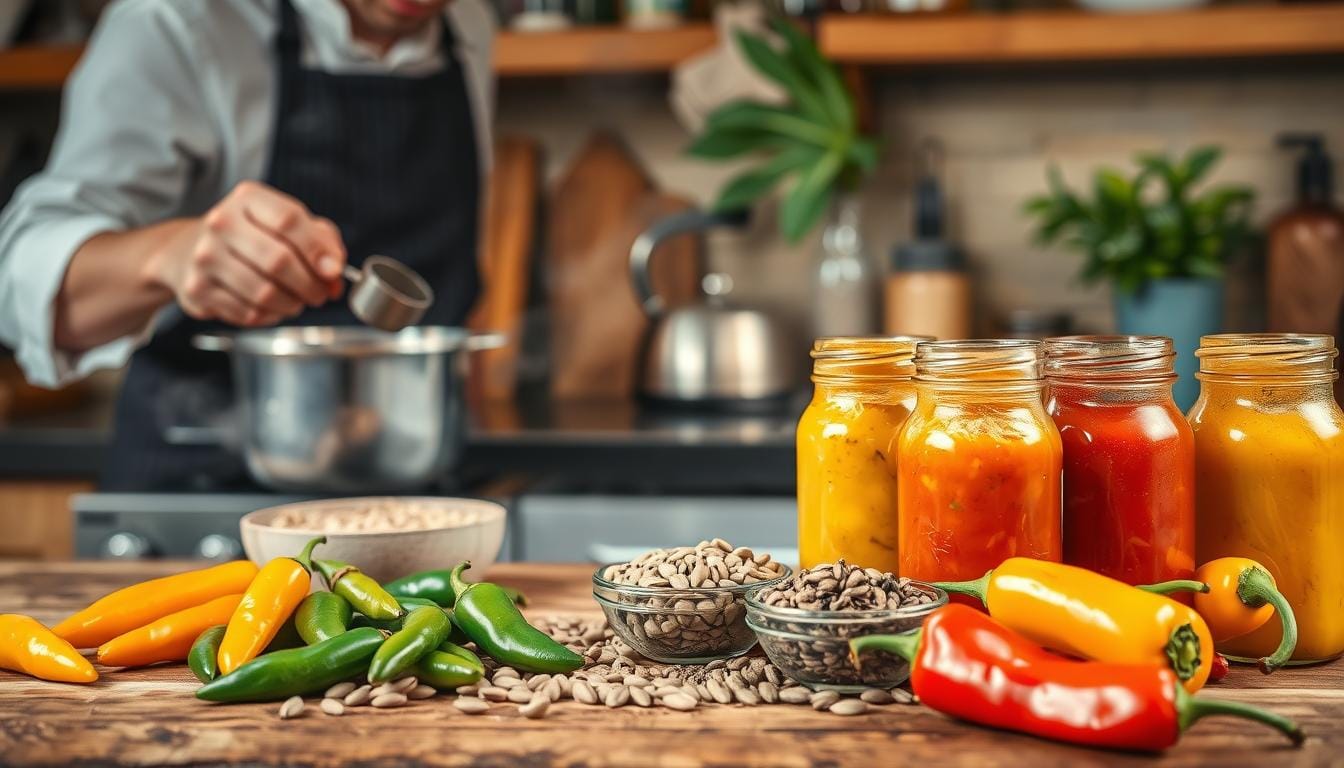
- Use a heavy-bottomed stockpot for even heat distribution
- Select Clear Jel as a superior thickening agent
- Implement continuous whisking to prevent splattering
- Ensure thorough boiling to activate thickening agents
“The secret to perfect sauce consistency lies in patience and technique.” – Culinary Expert
Temperature control is vital for your sauce. Start with slow heating and keep an eye on it.
| Technique | Benefits | Recommended Action |
|---|---|---|
| Slow Heating | Prevents burning | Medium-low heat setting |
| Continuous Stirring | Ensures smooth texture | Wooden spoon or silicone whisk |
| Clear Jel Application | Safe canning method | Mix with cold liquid before adding |
Pro tip: Always test your sauce’s consistency by cooling a small sample. The texture should coat the back of a spoon without running immediately.
Altitude can affect your cooking. At higher elevations, you might need to adjust cooking times and heat levels for your hot pepper mustard.
Safety Measures and Food Preservation
Making a piquant pepper and mustard blend needs careful food preservation. Your homemade dip should be handled right to keep it safe and tasty.
Food safety is key when making and storing your spicy condiment. Knowing the right ways to preserve it will let you enjoy it for months.
Proper Canning Methods
Canning your pepper mustard requires careful steps to avoid contamination:
- Use sterilized glass pint jars with new lids
- Maintain 1/2 inch headspace in each jar
- Process in boiling water bath for 5-10 minutes
- Adjust processing time for altitude differences
Storage Requirements
Acid levels are important for preservation. Different vinegars have different pH levels, affecting safety:
| Vinegar Type | pH Level |
|---|---|
| Apple Cider Vinegar | 3.10 |
| White Distilled Vinegar | 2.40 – 3.40 |
| Lemon Juice | 2.00 – 2.80 |
Shelf Life Guidelines
Your piquant pepper and mustard blend can be stored safely:
- Room temperature storage: Up to 1 year when properly canned
- Refrigerate after opening
- Consume within 3-4 months for best quality
“Proper preservation transforms a good condiment into an exceptional culinary experience.” – Culinary Preservation Expert
By following these tips, your savory hot pepper with mustard dip will stay delicious and safe to eat.
Flavor Variations and Customization Options
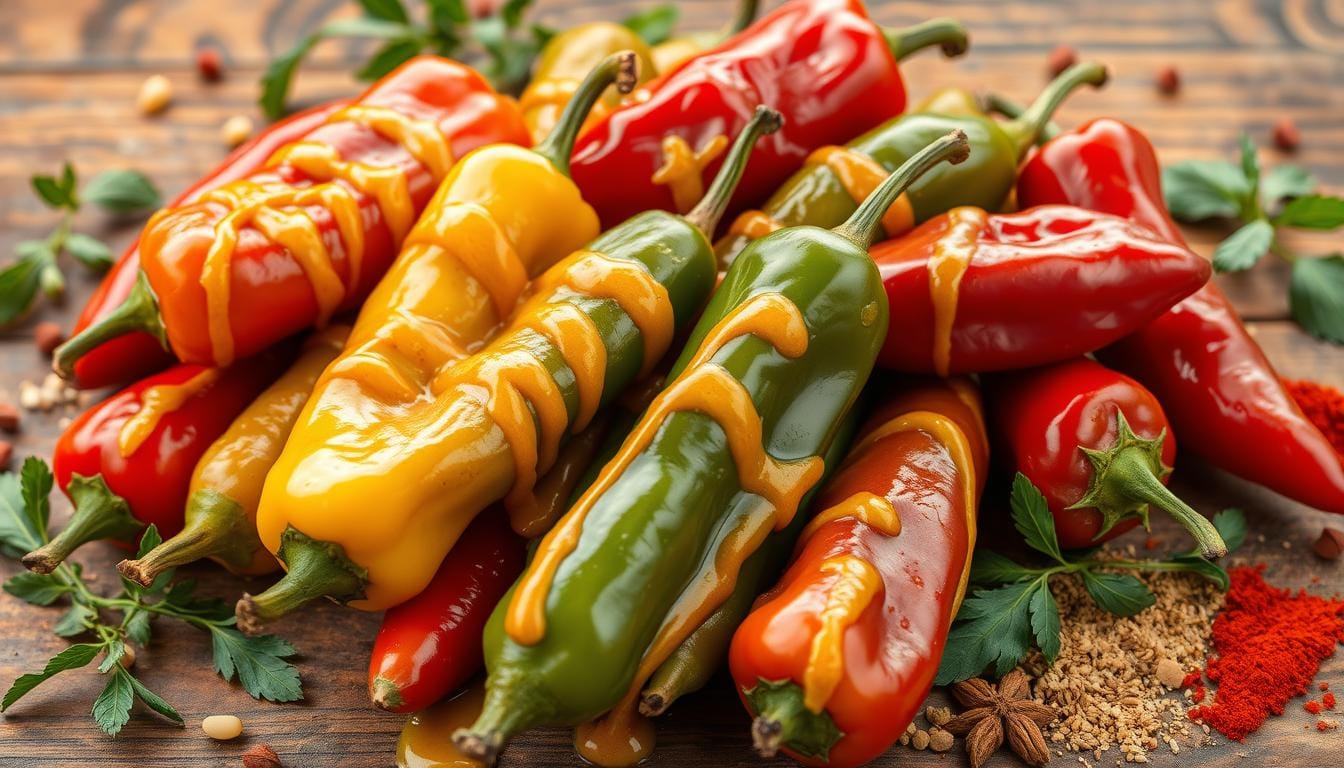
Creating your zesty mustardy pepper recipe is a fun journey. It can turn from a basic condiment into a special flavor with a few tweaks.
Pepper Variety Exploration
Try different peppers to make your mustard recipe unique:
- Sweet banana peppers for mild flavor
- Jalapeños for medium heat
- Habaneros for intense spiciness
Flavor Enhancement Techniques
Make your hot pepper with mustard recipe better with these tips:
- Add honey for a touch of sweetness
- Sprinkle turmeric for earthy notes
- Dash of cayenne for more heat
“The secret to an exceptional mustard is balance and personal creativity.” – Culinary Spice Experts
Vinegar and Sweetness Customization
Make your zesty mustardy pepper recipe stand out with vinegar and sugar:
- Apple cider vinegar for fruity notes
- Adjust sugar levels to balance heat
- Try different vinegar types
Remember, the best hot pepper with mustard recipe is yours to discover. Don’t hesitate to experiment and taste as you go!
Serving Suggestions and Pairing Ideas
Your homemade hot pepper spread opens up a world of culinary possibilities. This versatile condiment can transform ordinary meals into extraordinary culinary experiences with just a few creative touches.
Let’s explore some exciting ways to incorporate your spicy pepper mustard dish into various meals:
Meat Lover’s Pairings
- Spread on grilled hot dogs and burgers
- Marinade for pork roasts
- Glaze for roasted chicken
- Dipping sauce for barbecue meats
Vegetarian and Lighter Options
- Dressing for grilled vegetable wraps
- Topping for veggie pizza
- Mixed with cream cheese for a spicy dip
- Spread on sandwiches and charcuterie boards
To elevate your culinary experience, consider these creative pairing strategies:
| Dish Category | Recommended Mustard Usage | Flavor Profile |
|---|---|---|
| Mac and Cheese | 1 tablespoon | Tangy kick |
| Salad Dressing | 2-3 teaspoons | Zesty blend |
| BBQ Sauce | 1-2 tablespoons | Smoky heat |
“A great condiment can turn a simple meal into a memorable dining experience.” – Culinary Expert
Pro tip: Experiment with mixing your homemade hot pepper spread with honey or maple syrup to create unique dipping sauces that will surprise and delight your guests.
Troubleshooting Common Recipe Issues
Making the perfect tangy mustard pepper condiment needs focus and knowing common problems. Your fiery mustard pepper sauce might face some issues while making it. But, with the right steps, you can solve these problems.
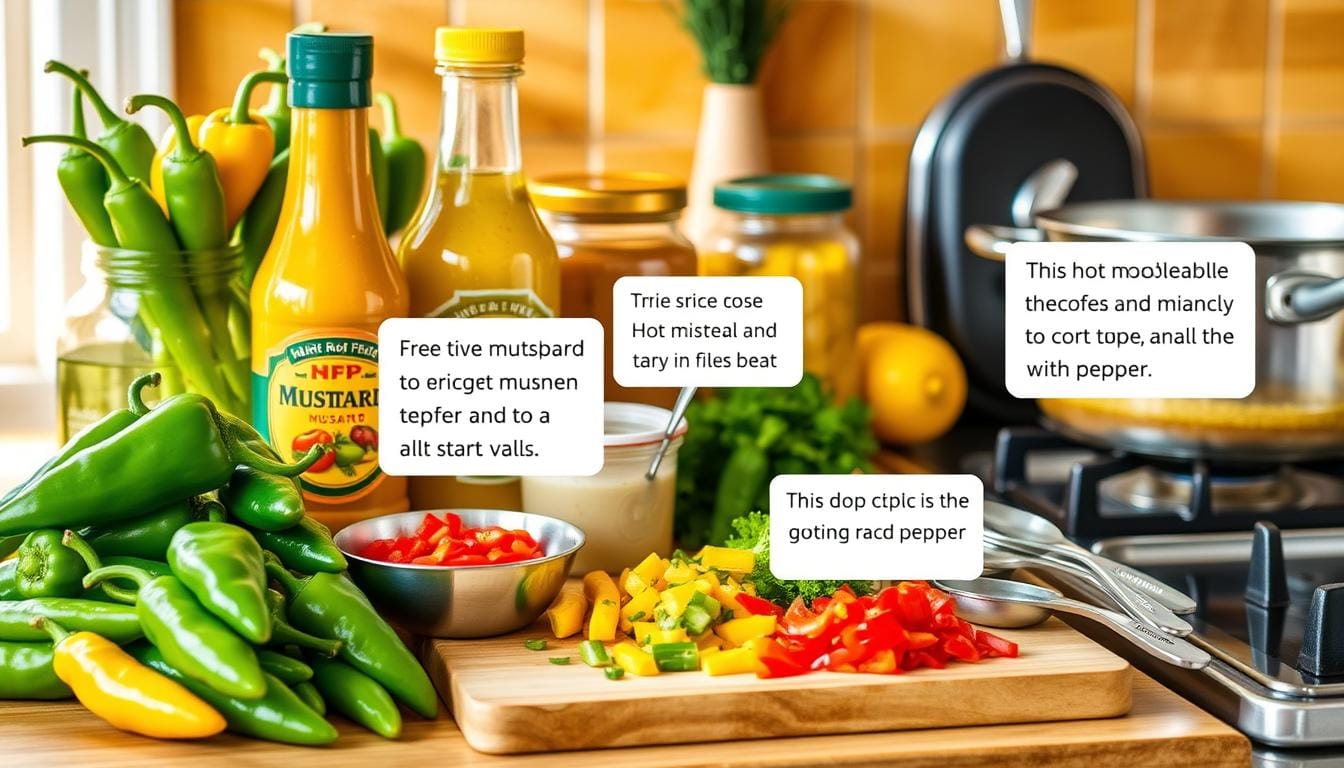
Texture Challenges and Solutions
Texture can be tricky when making your spicy condiment. Here are some key solutions:
- To prevent clumping, fully dissolve thickening agents like Clear Jel before adding to hot mixtures
- Stir constantly during cooking to maintain smooth consistency
- Use a whisk to break down any potential lumps
Managing Heat Levels
Controlling the spiciness of your mustard pepper sauce needs careful ingredient selection:
- Adjust pepper varieties to modify heat intensity
- Remove seeds and membranes to reduce spiciness
- Blend mild and hot peppers for balanced flavor
Storage Considerations
Proper preservation keeps your condiment tasty and safe:
| Storage Method | Duration | Recommendations |
|---|---|---|
| Refrigeration | 2-3 weeks | Use sterilized containers |
| Canning | Up to 1 year | Follow USDA canning guidelines |
“The secret to a perfect condiment is patience and precision in preparation.” – Culinary Expert
By knowing these troubleshooting tips, you’ll make a tangy mustard pepper condiment that’s always delicious and consistent.
Benefits of Homemade Hot Pepper Mustard
Making your own hot pepper mustard is a fun journey. It’s more than just buying it from the store. You get to play with flavors and enjoy health perks.
Homemade hot pepper mustard has many benefits. It’s a special treat because of these:
- Low-calorie option with only 3 calories per serving
- Complete control over ingredient quality
- No artificial preservatives or additives
- Potential health benefits from mustard seeds
Mustard seeds are packed with antioxidants. These might help fight cancer. You can pick from white, brown, or black seeds for different tastes.
“Homemade condiments are a gateway to culinary creativity and healthier eating.” – Culinary Experts
The making process can take 5-10 days. This lets you create deep, rich flavors. Once made, it can stay good in the fridge for up to 6 months.
Start making your own hot pepper mustard. It’s a way to make your cooking better and healthier. Enjoy a condiment that’s full of flavor and good for you.
Conclusion
Making a zesty mustardy pepper recipe at home changes how you cook. It lets you create a special sauce that makes any meal better. You can pick the ingredients, control the heat, and make a flavor that’s all your own.
Learning to make hot pepper mustard connects you to old cooking ways. It also lets you try new things. You’ll learn how to mix ingredients, store your sauce, and prepare it. This way, you can make a sauce that goes well with many foods, like chicken or fish.
Don’t worry if it takes a few tries to get it right. Every batch you make will help you get better. You’ll learn more about mixing flavors and make a sauce that’s truly yours. Enjoy making it and sharing it with others.
Your homemade zesty mustardy pepper recipe is more than just a sauce. It’s a way to celebrate your creativity and love for cooking. Start making it and explore the world of homemade mustard sauces in your kitchen.
